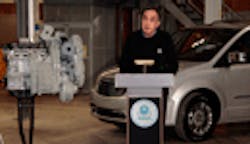Chrysler, EPA at work on light-vehicle hydraulic hybrid
A fuel-saving hybrid technology that has only been deployed for heavy-duty trucks to date will be tested on light-duty trucks and cars via a partnership formed by Chrysler Group LLC and the U.S. Environmental Protection Agency (EPA). “We’re looking to have a prototype on the road by November of this year,” Vince Muniga, a Chrysler spokesman, told Fleet Owner. “This is but one alternative power source we’re looking at to help us meet the new fuel economy rules [coming] in 2016.”
The project will focus initially on adapting a hydraulic hybrid system developed by EPA’s Ann Arbor, MI, research lab to a Chrysler Town & Country minivan equipped with a 2.4-liter, inline four-cylinder gasoline engine.
Read more "Green" stories from FleetOwner
Components of the hydraulic hybrid system include a 117 cubic centimeter (cc) engine pump, a 45-cc drive electric motor and a two-speed automatic transmission. Fluid for the system will be stored in a 14.4-gal high-pressure accumulator, Chrysler said.
The system produces engine torque that drives a hydraulic pump to charge the high-pressure accumulator up to 5,000 lbs per sq in (PSI), the OEM explained. The accumulator delivers that energy to the axle’s hydraulic motor, which supplies power to drive the wheels. The gasoline engine is deactivated once the accumulator charge is sufficient.
Chrysler’s Muniga said the engineering challenges of the project revolve around shrinking the system typically used on a heavy-duty truck down to something that can be fitted to a light-duty vehicle—as well as dampening the “side effects” such systems can create.
See video of Sergio Marchionne's speech
“Right now, hydraulic hybrid systems currently create more NVH [noise, vibration, harmonics] than consumers would accept,” he explained. “So this project will also look at ways to alleviate that.”
Sergio Marchionne, CEO of Chrysler Group, stated that the overall goal of the project is to evaluate and, hopefully, validate both fuel-efficiency gains and greenhouse gas reductions from using a light-duty hydraulic hybrid system.
“Hydraulic hybrid vehicle technology is one more promising path worth pursuing in the effort to reduce our carbon footprint,” Marchionne said. “It has shown substantial increases in fuel economy when compared with traditional powertrains in the same type of vehicles. Both parties hope to reduce the size and complexity of the hybrid system and produce a technology that is sensitive to the needs of drivers for smooth and quiet operation.”
About the Author
Sean Kilcarr
Editor in Chief
Sean Kilcarr is a former longtime FleetOwner senior editor who wrote for the publication from 2000 to 2018. He served as editor-in-chief from 2017 to 2018.
